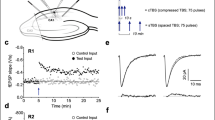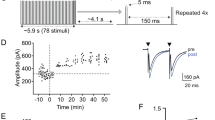Abstract
SHORT bursts of tetanic stimulation (10–50 Hz for 10–15 s) give rise to long-lasting potentiation (LLP) of synaptic transmission in the intact hippocampal formation1 and in hippocampal slices2. The potentiation may last several hours. Because of the time course and the small number of conditioning impulses required, the process may have general interest as a model for long-term plasticity in the nervous system. Studies of the mechanisms underlying LLP have been hampered, however, by lack of control with the size of the input volley and of data on membrane potential changes of the participating cells. Further, it is not known whether the potentiation is specific for the tetanised input. Schwartzkroin and Wester2 found an unchanged antidromic field potential, and concluded that there were no general postsynaptic changes. Lynch et al.3, however, found a reduction in glutamate sensitivity during the potentiated stage, and suggested that a reduction in excitability had taken place. We report here experiments on transverse hippocampal slices4 of guinea pigs in which we have monitored the size of two independent afferent inputs, one of which is tetanised to produce LLP, leaving the other as a control line to check for non-specific changes in excitability. Furthermore, intracellular recordings support our suggestion that LLP is caused by a specific augmentation of transmitter release.
This is a preview of subscription content, access via your institution
Access options
Subscribe to this journal
Receive 51 print issues and online access
$199.00 per year
only $3.90 per issue
Buy this article
- Purchase on Springer Link
- Instant access to full article PDF
Prices may be subject to local taxes which are calculated during checkout
Similar content being viewed by others
References
Bliss, T. V. P. & Lømo, T. J. Pkysiol. Lond. 232, 331–356 (1973).
Schwartzkroin, P. A. & Wester, K. Brain Res. 89, 107–119 (1975).
Lynch, G. S., Gribkoff, V. K. & Deadwyler, S. A. Nature 263, 151–153 (1976).
Skrede, K. K. & Westgaard, R. H. Brain Res. 35, 589–593 (1971).
Andersen, P., Bliss, T. V. P. & Skrede, K. K. Expl. Brain Res. 13, 208–221 (1971).
Andersen, P., Silfvenius, H., Sundberg, S. H. & Sveen, O. J. Physiol. Lond. 263, 104–105P (1977).
Author information
Authors and Affiliations
Rights and permissions
About this article
Cite this article
ANDERSEN, P., SUNDBERG, S., SVEEN, O. et al. Specific long-lasting potentiation of synaptic transmission in hippocampal slices. Nature 266, 736–737 (1977). https://doi.org/10.1038/266736a0
Received:
Accepted:
Issue Date:
DOI: https://doi.org/10.1038/266736a0
This article is cited by
-
The plasticitome of cortical interneurons
Nature Reviews Neuroscience (2023)
-
Local translation in neurons: visualization and function
Nature Structural & Molecular Biology (2019)
-
The 1980s: d-AP5, LTP and a Decade of NMDA Receptor Discoveries
Neurochemical Research (2019)
-
In memoriam: John Lisman – commentaries on CaMKII as a memory molecule
Molecular Brain (2018)
-
PSD95 nanoclusters are postsynaptic building blocks in hippocampus circuits
Scientific Reports (2016)
Comments
By submitting a comment you agree to abide by our Terms and Community Guidelines. If you find something abusive or that does not comply with our terms or guidelines please flag it as inappropriate.



